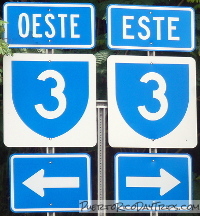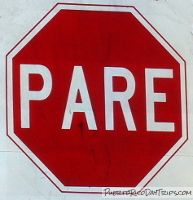Now that you have your rental car, you are free to explore! There are a few things you need to do before going too far. First, your best bet is to get a good driving map. Personally, we just use our smart phone and Google Maps and it works great. But if you want a printed map, you can call or write to the Puerto Rico Tourism Company (PRTC) for a free driving map, provided you still have a month or 2 before your visit. You can also buy maps online.
If you want to wait until you get here, you can buy driving maps at gas stations for a couple bucks. You can also stop into one of the Puerto Rico Tourism Company offices to pick up a free map. There’s a PRTC office right at the SJU airport. Your hotel or resort may also have free maps available — check at the front desk.

You can use a GPS unit, which will help a lot. But don’t rely solely on it, since sometimes you won’t be able to get a GPS signal and, oftentimes, places in Puerto Rico don’t have addresses that a GPS unit can understand. Although, if you have the GPS coordinates of a location, you should be in good shape.
You could always opt to ask someone for directions. Although helpful, many locals give very landmark-specific directions, without using highway numbers or compass direction. If you don’t feel comfortable with that (though they are usually pretty accurate), call your destination for something more specific!
Another thing to take into consideration is how long it will take to drive from point A to point B. Don’t expect the time estimates given by Google Maps or MapQuest to be accurate. For example, those services don’t realize that it can sometimes take 2 or 3 hours to drive 60 miles here on the island.


Rules of the Road
Puerto Rico’s driving rules are almost the same as any US State. We drive on the right side of the road, just as in the States. Road conditions are usually fine, though there will be some potholes here and there. Road signs use universal traffic signs — the shape and colors are the same as in the States, but the words will be in Spanish (see below for some translations). Seat belts are mandatory and must be used by all people in the car. Child seats are mandatory for kids 4 and under, booster seats required for children until 9 years old. Children until 12 years old must ride in back seat. Note- these car seat rules do not apply to taxis or school buses.
Highway road numbers can give you a clue as to what type of road you’re on. Single-digit roads (like Route 1 and Route 3) are the older “main highways” that often have traffic lights every couple of blocks. Double-digit roads (like Route 18 and Route 66) are either newer major highways or toll roads. Triple-digit roads (like Road 186 and Road 191) are smaller, “country roads”. Four-digit roads (like Road 9966 and Road 9989) are little, sometimes single-lane roads that you really shouldn’t be on unless you know specifically where you’re going.

There are six toll roads on the island — Route 66, Route 52, Route 22, RT.20, RT 5 and Route 53 — all with 55-65MPH speed limits. However, you need to be aware of how much the toll will be and which lane to get in. Note- RT 5, RT 22, and the end of RT 66 now only accept the Autoexpreso tag (“solo Sello”), so you must have approved payment for the tag when renting the car to use these roads to avoid fines at the rental agency. The AutoExpreso lanes are on the left (ALWAYS!) or in the middle marked with a “T”. You can ONLY USE THESE LANES WITH AN AUTO EXPRESO TAG, or you will be charged a HEFTY fine! Some of the tolls are now (8/11) Changeless- you need to buy a MovilCash card or use an AutoExpreso Tag only, so you will have to rent the tag along with the car. The Tarjeta MóvilCash (a toll card)is available for these highways, but you need to wait on line in the Venta y Recarga Plus (R+) lanes (these are on the extreme right). You pay $5.00 and they start off with a balance of $4.00 to pay the tolls (only using the R+ lanes). You can buy it with dollar bills (no change, credit or ATH) and any change due back will go on the the balance. If you are on a road that allow cash at tolls, you can use the middle lanes marked with a C. If your rental car has an AutoExpreso tag, and you use the R/R+ Movilcash lane, the toll will be charged to your toll tag, even if you payed the toll with money/Movil cash card.!
Finally, and this is important, the San Juan area is very congested — there will be traffic that will slow you down. Guaranteed. Leave plenty of time if you need to be somewhere at a certain time and you will be traveling on roads near San Juan. Rush hour going toward San Juan is from 6am to 9am. Rush hour going away from San Juan is 4pm to 7pm. Try to avoid going toward the city in the morning or coming back through the city in the afternoon at those times. The traffic can easily turn a 45-minute trip into a 3-hour nightmare (we know, we’ve done it)!

